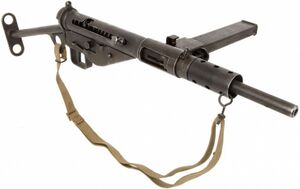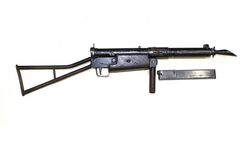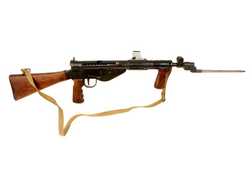Shippard-Tamaki SMG
This article is incomplete because it is pending further input from participants, or it is a work-in-progress by one author. Please comment on this article's talk page to share your input, comments and questions. Note: To contribute to this article, you may need to seek help from the author(s) of this page. |
| Shippard-Tamaki Submachine gun | |
|---|---|
 Shippard-Tamaki Submachine gun | |
| Type | Submachine gun |
| Place of origin | United Kingdom |
| Service history | |
| In service | 1936–Present (used by reservists) |
| Used by | See Users |
| Production history | |
| Designed | 1936 |
| Manufacturer | RSAF Luyties Group Co. Ltd. (modern productions) |
| Produced | 1941– (version dependent) |
| No. built | 3.7–9.6 million (all variants, depending on source) |
| Variants | Mk. I, II, IIS, III, IV, V, VI |
| Specifications | |
| Weight | 3.2 kg (7.1 lb) (Mk. II) |
| Length | 760 mm (30 in) |
| Barrel length | 196 mm (7.7 in) |
| Cartridge | 9×19mm Parabellum |
| Action | Blowback-operated, Open bolt |
| Rate of fire | version dependent; ~500-600 round/min |
| Muzzle velocity | 365 m/s (1,198 ft/s) 305 m/s (1,001 ft/s) (suppressed models) |
| Effective firing range | 100 m |
| Feed system | 32-round detachable box magazine |
| Sights | fixed peep rear, post front |
The Shippard-Tamaki SMG (or commonly known by its shortened name SHITA Gun) is a family of Lucian submachine guns chambered in 9×19mm and used extensively by Lucis Commonwealth forces throughout the Second Europan War, War of Lorican Aggression, and even into the Imperial Crisis as a personal defence and reserve commando weapon, where its use as a concealable suppressed automatic small arms weapon was highly valued. They were notable for having a simple design and very low production cost, which made it continuously being used as a highly effective insurgent's weapon, with notable use by the Imperial resistance group, the Gneisenau Circle. It was succeeded by the Sherwood Submachine gun.
The gun was named after its inventors, Maj. Reginald Shippard and Nihhonese engineer Keita Tamaki. Over 5 million Shita guns were made worldwide, making it the most produced automatic small arms in Eordis.
Development
Service
Variants
Mk. I
The first Shita gun variant made. The model had a conical flash hider and fine finish. It had a wooden foregrip and forward handle (although at times it was made of steel), as well for a section of the stock. The stock was a small tube outline. One unique feature was that the front grip could be rotated forward to make it easier to stow. The barrel sleeve extended all the way to the end, where it met the flash hider. Along the top of the tube surrounding the barrel was a line of small holes and its sights were configured somewhat directly.
Although the first Sten variant was considered high quality and had been made well, it still proved expensive, costing at about 50 Lucian Gils to produce, hence a further simplification was needed.
The subvariant of the Mk. I, called the Mk. I* was the simplification of the first Sten variant. It removed all wooden furniture and the flash hider for simple production. More than 375,000 in total were produced.
Mk. II
The Mk. II was the most common variant, with two million units produced. It was much rougher than the Mk. I. The flash hider and front grip were omitted. A removable barrel was now provided which projected 3 inches beyond the barrel sleeve. A special catch allowed the magazine to be slid partly out of the magazine housing and the housing rotated 90 degrees counter-clockwise, together covering the ejection port and allowing the weapon and magazine to lie flat on its side.
To hold the Mk. II, it was instructed that it be held by the barrel shroud or under the receiver. Although some held it by the magazine, it was found in tests that holding it by the magazine will jam the weapon easily. Although holding it by the magazine housing was slightly better, the tendency for the shooter to eject the magazine was likely, hence it was never acceptable to hold the Shita by the magazine. Later during the war, a special suppressor was developed for the Mk. II that allowed it to be used for covert and special operations. This was dubbed as the Mk. IIS or the Mk. II Special/Suppressed.
Mk. II (Rubrumian)
During the Second Europan War, a version of the Shita gun was produced at the Rubrumian Arsenals in Long Branch, Ontaria in Toronto, Ontaria. This was very similar to the regular Mark II, with a different stock ('skeleton' type instead of strut type) and improved quality of manufacture. It was first used in combat in Operation Alderhall in 1939.
The same Rubrumian version was used by the Erebonian Empire and was manufactured by Rainford Group under license from Rubrumian Arsenals (now known as Ontaria National Arms) and RSAF. The difference between Erebonian and Rubrumian Stens were the markings. Often times, Erebonian manufacturers would stamp the gun with the Erebonian coat of arms by the underside of the magazine housing. Instead of blued, Erebonian-made Stens were often parkerized to prevent the occurrence of rust. And sometimes, manufacturers would adopt the strut stock instead of the skeleton stock often to save on costs. These Strut-stock Stens were often produced at factories located near the Calvardian and Imperial borders.
Today, the weapon is used as a personal self-defence and as a covert weapon by the Railway Military Police and the Thors Military Academy as a training and self-defence weapon along with the Lena-Elfield.
Mark II:
- Overall length: 896 mm (35.3 in)
- Barrel length: 198 mm (7.8 in)
- Weight: 3.8 kg (8.4 lb)
Mk. III
The Mk. III was a further simplification of the Mk. II, in which the entire body was a one-piece construction. The magazine housing was fixed in place and the barrel could not be removed. As a result, if the weapon was damaged, it was disposed of. While it was quicker, and it offered better maintenance, it was unpopular with troops, hence it was rarely seen in frontline combat during the war. It was pulled out of service in 1947.
Mk. IV
The Mk. IV was seen as a paratrooper variant, with a foldable stock, shorter barrel, and a rear pistol grip. But it never saw service due it being seen as impractical and unreliable.
Mk. V
The Mk. V was by far considered to be the most reliable Sten variant made. It was a better-quality, more elaborate version of the Mk. II. The Mk. V's features included a front and rear wooden pistol grip, a wooden stock, and a bayonet mount. The front sight was taken from the Lena-Elfield No. 4. Overall, the weapon was of better quality manufacture than the Mk. II and Mk. III.
The Mk. V was highly popular with SAS, Commando, and Airbourne units throughout the war, seeing service even beyond the 1960s. It was retired from the Lucis Army service in the 1980s. Although the Mk. V still continues service as a personal defence weapon throughout several military academy institutions, law enforcement units, militia forces, and as a reservists weapon.
Mk. VI
The Mk. VI was the last Shita variant made. It was a suppressed variant of the Mk. V. It was also the heaviest due to the added weight of the suppressor, as well as using a wooden pistol grip and stock.
The Mk. V's popularity prompted the development of a suppressed variant of the latter by the Special Operations Executive for use in clandestine operations, starting with the Mk. II(S) in 1942. Owing to their tendency to overheat, they were fired in short bursts or single shots.
Users
Current Users
![]() Alteria
Alteria
![]() Basel-Ebel: Still in use in certain army units as a reservist weapon, as well as law enforcement personnel.
Basel-Ebel: Still in use in certain army units as a reservist weapon, as well as law enforcement personnel.
![]() Erebonian Empire: Still in use by the Thors Military Academy, Railway Military Police, as well as law enforcement personnel.
Erebonian Empire: Still in use by the Thors Military Academy, Railway Military Police, as well as law enforcement personnel.
![]() Gallia-Bruhl: Still in use as a personal defence weapon by Lanseal students and a substitute weapon by the Gallian militia.
Gallia-Bruhl: Still in use as a personal defence weapon by Lanseal students and a substitute weapon by the Gallian militia.
![]() Jutland-Gimli
Jutland-Gimli
![]() New Akiba: Still in use in certain army units as a reservist weapon.
New Akiba: Still in use in certain army units as a reservist weapon.
![]() Nihhon-koku: Still in use as a personal defence weapon by tank crews, academies, and law enforcement personnel.
Nihhon-koku: Still in use as a personal defence weapon by tank crews, academies, and law enforcement personnel.
![]() Rubrum: Still in use in certain army units as a reservist weapon, particularly by the Rubrumian Mountain Regiment.
Rubrum: Still in use in certain army units as a reservist weapon, particularly by the Rubrumian Mountain Regiment.
![]() United Kingdom: Still in use in certain army units as a reservist weapon, and by other law enforcement personnel.
United Kingdom: Still in use in certain army units as a reservist weapon, and by other law enforcement personnel.
![]() Zanarkand: Still in use in certain army units as a reservist weapon.
Zanarkand: Still in use in certain army units as a reservist weapon.
Former Users
![]() Altissia
Altissia
![]() Bethausia: 1940-1990
Bethausia: 1940-1990
![]() Concordia and the Soryu
Concordia and the Soryu
![]() Joyonghea: 1940-1975
Joyonghea: 1940-1975
![]() Lestallum
Lestallum
![]() Nibelheim-Saxe-Hanover
Nibelheim-Saxe-Hanover
![]() Taoyuan: 1947-1990
Taoyuan: 1947-1990
![]() Tenebrae and Solheim: rarely used from 1987.
Tenebrae and Solheim: rarely used from 1987.




